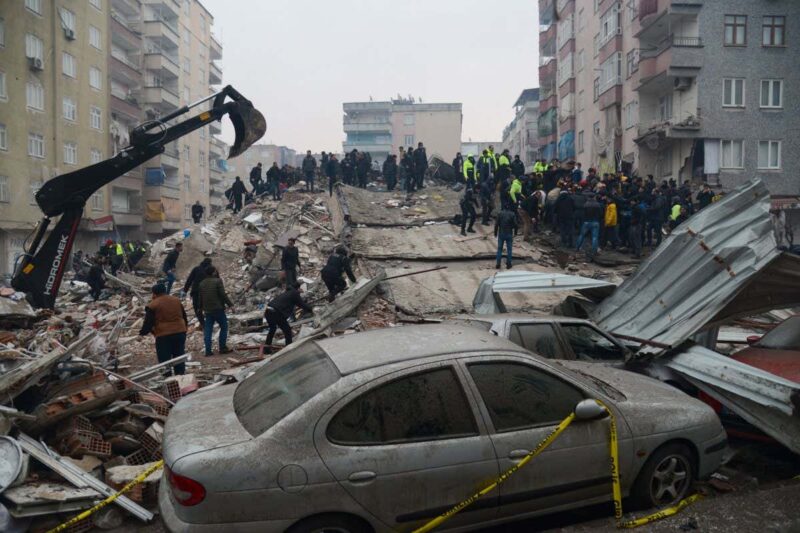People search for survivors in Diyarbakir, Turkey, after the initial 7.8-magnitude earthquake
ILYAS AKENGIN/AFP via Getty Images
Two major earthquakes have hit Turkey and Syria in less than 10 hours, causing extensive damage and resulting in a death toll of at least 1500 people.
The first earthquake, measuring 7.8-magnitude, struck near the Turkish city of Gaziantep at 1:17 am UTC on February 6th. This was followed by a 7.5-magnitude quake approximately 130 kilometers north of Gaziantep at 10:24 am, according to the US Geological Survey.
These earthquakes have brought chaos to Turkey and Syria, burying individuals under collapsed structures and causing significant damage to infrastructure such as roads, power lines, and sewage systems.
The official death toll across both countries had already surpassed 1500 by midday UTC, and authorities anticipate it will continue to rise rapidly in the coming days.
The earthquakes occurred along the East Anatolian fault, which runs through eastern Turkey from southwest to northeast. The initial quake, which struck while people were sleeping, caused tremors as far away as Cyprus and Egypt.
Scientists believe that the second tremor was likely a substantial aftershock triggered by the initial movement of tectonic plates that caused the first earthquake. David Rothery from the Open University in the UK explains that when one section jerks, it sets off a chain reaction, leading to jerking in other areas as well.
However, there is a possibility that the second quake could have been caused by the rupture of an associated fault segment stressed by the first earthquake, which would be considered a separate event.
This disaster marks the most severe earthquake-induced catastrophe in Turkey since the 1939 7.8-magnitude earthquake in Erzincan, which claimed the lives of 33,000 people. Turkish President Recep Tayyip Erdoğan stated in a press conference that “everyone is putting their heart and soul” into rescue efforts.
Earthquakes rated 7 to 7.9 on the moment magnitude scale are considered major events that can lead to the partial or complete collapse of buildings.
International search and rescue organizations are now working against time to deploy teams to the most affected areas in order to rescue people trapped under the rubble. Expert warns that the chance of survival decreases significantly after the first 24 hours, but swift travel to affected regions is made challenging by cold weather, the civil war in Syria, and the chaos caused by the two earthquakes.
Poor quality construction is likely a major factor in the high number of casualties, says Bill McGuire from University College London. Looking at images from the affected cities, it is evident that rescuers have an immense task ahead, McGuire explains. Many of the collapsed buildings appear to have been apartment blocks that suffered pancake collapse, where floors and walls were not well connected, resulting in each floor collapsing vertically onto those below, leaving concrete layers stacked like a deck of cards with few surviving spaces.
Prioritizing the provision of water, food, and shelter to displaced individuals is crucial, especially with local temperatures expected to drop below -4°C (25°F) overnight. Ilan Kelman, also from University College London, warns that there may be severe deaths from hypothermia and other weather-related conditions.
Seismologists face significant challenges in providing advance warnings for earthquakes, making the construction of earthquake-resistant buildings and infrastructure the best defense against major disasters.
Since 2004, all construction in Turkey has been required to adhere to modern earthquake-proof standards. However, both Syria and Turkey still have thousands of buildings that are not designed to withstand major seismic activity, despite being in a highly earthquake-prone region.
“This earthquake was survivable,” says Kelman. “If the infrastructure had been built correctly, this would have been a major earthquake but not an earthquake disaster.”
Topics:








